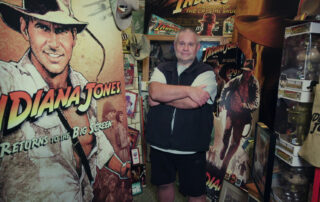At a young age in 1985, Ankur Malhotra says he was “hooked on vinyl records” and the music his father would bring home from the United States. Music was always spinning around in his head. It was the soundtrack to his life in New Delhi, India.
In 2009, while volunteering at Madison’s various music festivals and listening to folk music from across the world, he noticed music from India was missing. He says, “That’s when my longtime friend Ashutosh and I decided to start our own record label.”
Ankur and Ashutosh decided to call their label Amarrass Records. “Amar”- meaning eternal and “Rass” meaning essence. India is a country steeped in musical culture so the essence of the music they were trying to capture could last forever.
Back in India in 2010, they packed up Ashotosh’s car full of cobbled-together recording equipment, and drove hundreds of miles into the desert of Rajasthan, going village to village in search of the musical masters.
They met Lakha Khan, a seventh-generation master of the Sindhi sarangi, a 27-string Indian folk fiddle. Khan played a song, one of hundreds “recorded” in his head. Ankur and Ashutosh felt a responsibility to preserve this ancient music. Not just to collect it, but to also help inspire the next generation of Indian artists.
On that same trip to the desert, they were introduced to a musician named Manga. When they heard him sing, they knew what to do. Their label – Amarrass Records – formed a band and Manga became the voice of the Barmer Boys.
Barmer Boys present a unique fusion of the soulful elements of Manganiyar folk music with celebratory singing and the percussive sounds of the dholak, khartal and morchang. It also included contemporary sounds like beatboxing and live DJing.
India is a country of over 1.3 billion people. To their knowledge, Ankur and Ashutosh are the only ones making hand-cut vinyl records.
“I am always driven by the realization that these are perhaps some of the last great players of this ancient music,” says Ankur. “So by preserving these songs and these sounds, my hope is that new generations will carry on this music’s legacy, and perhaps be inspired to create something new.”
Below is a transcript of the story with links to music heard throughout the piece.
====
ANKUR: That’s me…Ankur Malhotra. I went to a Catholic school, and I just failed one of their mandatory “hair checks.” So I’m at the neighborhood barbershop getting my hair… “corrected.”
Music: “Hopelessness” (Ashaon Ka Hua Khatma)
ANKUR: As my long hair falls in line…my mind tends to drift, absorbing the sounds around me.
This is one of my first recollections of the wonders of music. This is when I really started to tune in.
Music was already my life, and even at a young age, I was a freaky tweaker.
Music: “Proverbial Track” (Duniya)
ANKUR: If you needed a cassette tape spliced, or your tape heads aligned…I was the guy.
By this time, I was also hooked on vinyl and the music my father was bringing from the States. This music was always spinning around in my head. It was the soundtrack to my life.
Music: “Sara Kantigui” [Live] (Madou Sifiki Diabate)
ANKUR: Turn of the last century, I ended up at UW-Madison, getting an MBA in Entrepreneurship and working with tech start-ups. But something was pulling me back to music and to my homeland India. That’s when my longtime friend Ashutosh and I decided to start our own record label.
We had always been fans of the American folk and blues masters…and then we started asking ourselves, “Who are these Indian bluesmen? Who are these Indian folk stars?” And then we couldn’t come up with their names.
We decided to call our label Amarrass Records. “Amar”- means eternal and “Rass” means the essence. The essence of the music that we are trying to capture would last forever. India is a country steeped in musical tradition and musical culture…and we knew these masters were out there…so what if we go find them?
Music: “Instrumental Jam #3” (Barmer Boys)
ANKUR: So we packed up our car full of cobbled-together recording equipment, and drove hundreds of miles into the desert of Rajasthan, going village to village in search of the musical masters. We’d also heard about the seventh-generation musician Lakha Khan, player of the Sindhi sarangi, a 27-string Indian folk fiddle. So…we went to his home and he played us a song.
Music: “Tulsi Kya Karoon” (Lakha Khan)
ANKUR: This is one of hundreds of his songs…but they’re all in his head. And, at the time, his two sons hadn’t really continued with the family’s legacy of playing the sarangi.
So when Lakha Khan eventually leaves this world…do these songs just disappear? That notion weighed heavy on him…and you can hear a sadness… a deep melancholy in his voice. “What will I leave behind?”
Music: “Bole to Mitho Lage” (Barmer Boys)
ANKUR: On that same trip to the desert, we were introduced to a musician named Manga. And when we heard him sing, we instantly knew that voice needed to be heard. But it also needed a band, and then as a label, we decided to form one. This would be the voice of Barmer Boys.
Barmer Boys present a unique fusion of the old and the new, melding traditional songs of celebration, the percussive sounds of the dholak, khartal, morchang and fusing in contemporary elements like beat-boxing and DJ-ing.
Music: “Bole to [Awaare Remix]” (Barmer Boys)
ANKUR: So here we are today…in our tiny studio in New Delhi, making hand-cut vinyl records. India is a country of over 1.3 billion people, and we are the only ones making vinyl. Amarrass Records has worked with over a hundred artists, and we currently manage seven groups that are touring all over the world.
I’ve always driven by the realization that these are perhaps some of the last great players of this ancient music. So by preserving these songs and these sounds, my hope is that new generations will carry on this music’s legacy, and perhaps be inspired to create something new.
Related Links for this Article
Wisconsin Public Radio's "Wisconsin Life" story about Amarrass Records








